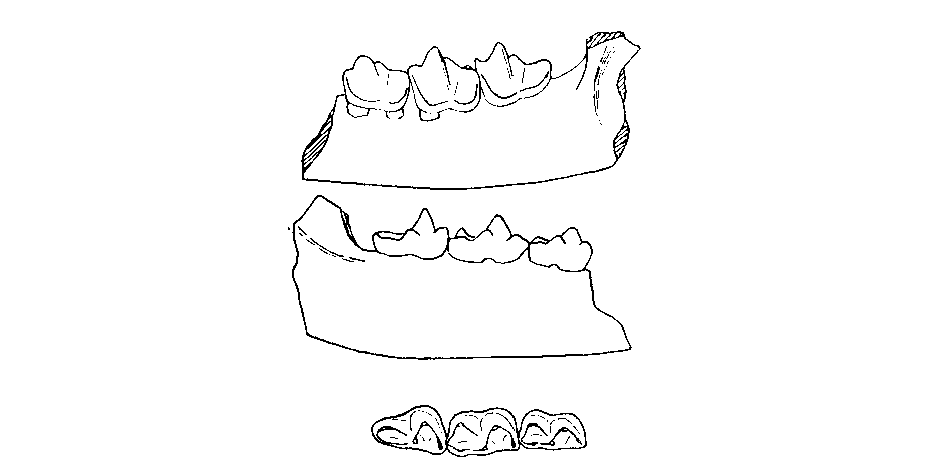Introduction
In this paper are described two bats from Lower Miocene sites in Kenya colony. Incomplete skull of a batis found at Koru in 1931, and subsequently several specimens were obtained from Songhor and Rusinga Island. Detailled accounts of the sites are given by Kent (1944), Le Gros Clark & Leake (1951) and Shackleton (1951).The bats appear to belog to families still living in Africa : Emballonuridae and Megadermidae. Each is represented by a single specimen, from Koru ans Rusinga respectively.
Order Chiroptera

- Family : Megadermidae
- Genus : indeterminate
- Name : indeterminate
- Material : a mandibular fragment with weathered M1 – M3. Rs.171.47, from site R.106, Rusinga Island, Lake Vistoria.
- Description : the jaw fragment is broken anteriorly in front of M1, and posteriorly it shows only the beginning of the coronoid process.It is comparatively large for a bat : M1 – M3 = 8.3 mm, internal depth of ramus below M1 = 4 mm.The anterior edge of the coronoid process is nearly vertical, The process seems to have been stout, with a deep excavation for muscle attachment on the lateral side. The horzonal ramus is deeper than en regente Megardermidae, but resemble that of the Emballonurid Saccolaimus peli, with which it also agrees in size. The enamel of the molars has been damaged by weathering, but the main features of the pattern can be made out with some assurance. The protoconid is the highest especiallx on M1. The metaconid is placed further back on the crown than the protoconid, more so on M1 than on M2 or M3. The talonid is shorter than the trigonid; the V-shaped hypoconid i lower than the metaconid. There is a small hypoconulid on the posterior border, and near it a small entoconid is present, at least on M2. The talonid is reduced in width on M3, but a race of the basin remains. On all three molars there is a buccal cinglum, which is especially wide antero-buccaly to the protoconid. M1 differs from M2 in being slightly shorter and narrower, and in the more widely open angle of the trigonid.
| Megadermidae, Rs 171.47 | |
| M1 – M3 inclusive | 9.5 mm |
| Internal depth of mandibule below M2 | 4.0 |
| M1, ap x tr | 2.8 x 1.7 |
| M2, ap x tr | 3.0 x 1.9 |
| M3, ap x tr | 2.9 x 1.8 |
- Relationships : the lower molar pattern, with backwardly displaced metaconid and reduced talonid, is found in the families Megadermidae, Nycteridae, Rhinolophidae and Hipposideridae among Old World bats. A reduction of the talonid of M3 to the extent seen on the Rusinga specimen is found on some members of most families except, apparently, the Verpertilionidae. Only in the Megadermatidae is M1 shorter than M2, and the specimen is therefore reffered to that family.
According to Anderson & Wroughton (1907) the recent Megadermatidae fall into two groups, one african, consisting of the genera Lavia and Cardioderma, and the other oriental and australian, with the genera Megaderma, Eucheira (Lyroderma) and Macroderma. Of the two african genera, Lavia differs from the Rusinga form in the less reduced talonid and smaller trigonid angle, but the molar patterns of the fossil agree quite closely with Cardioderma, as well with the oriental Megaderma.
Among fossil forms, the Rusinga specimen agrees most closely with Necromantis, from the French Phosporites (re-described and figured by Revilliod, 1920). In Necromantis, however, M1 is as long as M2. Miomegaderma (Gaillard, 1929) differs from the Rusinga form in the more widely open trigonid of M1, the metaconid of whichs greatly reduced.
Ref. : Fossils Mammals of Africa : Insectivora and Chiroptera from the Miocene rocks of Kenya colony, PM Butler & AT Hopwod, British Museum (Natural History), London, 1957